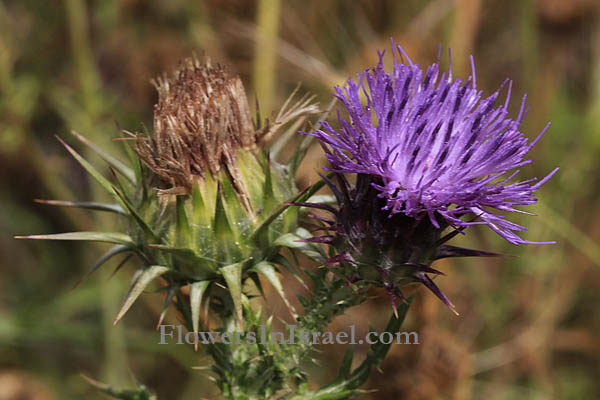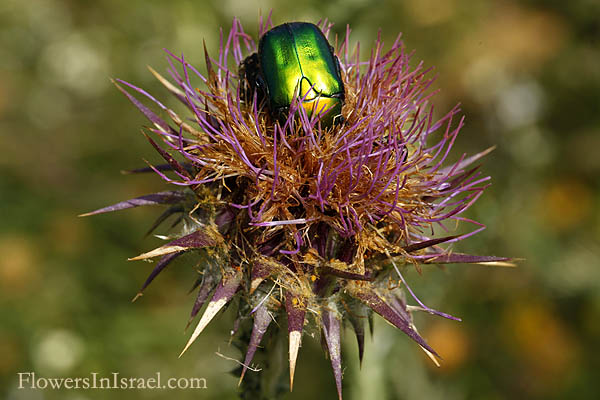Hebrew: חוחן קרדני, Arabic: عثور خرفيش
| Scientific name: | Onopordum carduiforme Boiss. | |
| Synonym name: | Onopordum telavivense Eig. | |
| Common name: | False plumed-thistle | |
| Hebrew name: | חוחן קרדני | |
| Arabic name: | عثور خرفيش | |
| Family: | Compositae / Asteraceae, מורכבים |

Location: Bnei Zion Nature Reserve |
| Life form: | Hemicryptophyte | |
| Spinescence: | Leaves, bracts | |
| Branching: | 2-10cm above the ground | |
| Leaves: | Alternate, rosette, dissected, pinnate, dentate or serrate, spinescent | |
| Flowers: | Length of peduncles: 10-30 cm; Color corolla: pink, violet, spinescent bracts; head diameter: 20-40 mm | |
| Flowering Period: | March, April, May, June | |
| Soils: | sandy-loamy and sandy-silty on sandstone or alluvium | |
| Habitat: | Batha, Phrygana | |
| Distribution: | Coastal Galilee, Acco Plain, Coastal Carmel, Sharon Plain, Philistean Plain, Shefela, Northern Negev | |
| Altitude: | 10-200 (-850) m above sea level | |
| Chorotype: | Mediterranean | |
| Summer shedding: | Ephemeral |

Cetonidae (Cetoniinae), flower beetle: Cetonia aurata Location: Netanya, the Dora rain pool Derivation of the botanical name: Onopordum, an early Latin name for a group of thistles, derived from the Greek onos, meaning "ass", and porde, flatulence, because of the belief that the plant caused flatulence in donkeys. carduiforme, cardu noun/m "thistle", "forme", to be in the form or shape of... thistle formed. telavivense,Tel Aviv, Israel. The Hebrew name: חוחן, khokhan, derivated from חוח, khokh, briar, thorn; related to Aramaic: חוחא, Akkadian: hàh ( = thorn), hahhu, hàyahu ( = thorn).
Onopordum carduiforme Boiss. prefers the sandy soils of the coastal plain of Israel and differs by its habitus and flower color from the Onopordum blancheanum (Eig) Danin that is confined to basalt soils at an altitude of 300-1000 m. 
Location: Netanya, the Dora rain pool 
Location: Netanya, the Dora rain pool 
Location: Netanya, the Dora rain pool |